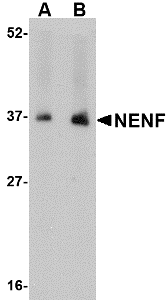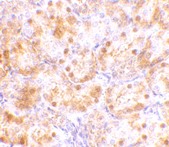Catalog# :4753
NENF is a secreted protein that is expressed in neurons but not glial cells of the brain. This protein has neurotrophic activity in primary cultured mouse neurons but not mitogenic activity in primary cultured mouse astrocytes. NENF activated mitogen-activated protein (MAP) and phosphotidylinositol-3 kinase pathways and could be inhibited by pertussis toxin but not receptor tyrosine kinases, suggesting that NENF acts through a Gi/Go-protein-coupled receptor. Despite its predicted molecular weight of ~20kDa, NENF is observed at 37kDa in SDS-PAGE.
Additional Names : NENF, Neuron derived neurotrophic factor, neudesin, CIR2, SPUF, SCIRP10
 Description
DescriptionLeft: Western blot analysis of NENF in human kidney tissue lysate with NENF antibody at (A) 1 and (B) 2 µg/ml.
b>Below:Immunohistochemistry of NENF in rat kidney tissue with NENF antibody at 10 μg/ml.
Other Product Images
 Source :NENF antibody was raised against a 15 amino acid peptide from near the carboxy terminus of human NENF.
Source :NENF antibody was raised against a 15 amino acid peptide from near the carboxy terminus of human NENF.Purification : Affinity chromatography purified via peptide column
Clonality and Clone : This is a polyclonal antibody.
Host : NENF antibody was raised in rabbit.
Please use anti-rabbit secondary antibodies.
Application : NENF antibody can be used for detection of NENF by Western blot at 1 – 2 µg/ml.
Tested Application(s) : E, WB, IHC
Buffer : Antibody is supplied in PBS containing 0.02% sodium azide.
Blocking Peptide :Cat.No. 4753P - NENF Peptide
Long-Term Storage : NENF antibody can be stored at 4ºC, stable for one year. As with all antibodies care should be taken to avoid repeated freeze thaw cycles. Antibodies should not be exposed to prolonged high temperatures.
Positive Control :
1. Cat. No. 1308 - Human Small Intestine Tissue Lysate
Species Reactivity : H, M, R
GI Number : 7019545
Accession Number : NP_037481
Short Description : Neuron derived neurotrophic factor
References
1. Kimura I, Yoshioka M, Konishi M, et al. Neudesin, a novel secreted protein with a unique primary structure and neurotrophic activity. J. Neurosci. Res. 2005; 79:287-94.

No comments:
Post a Comment